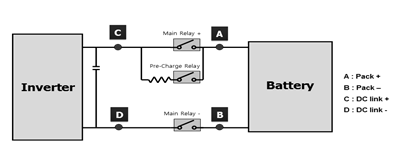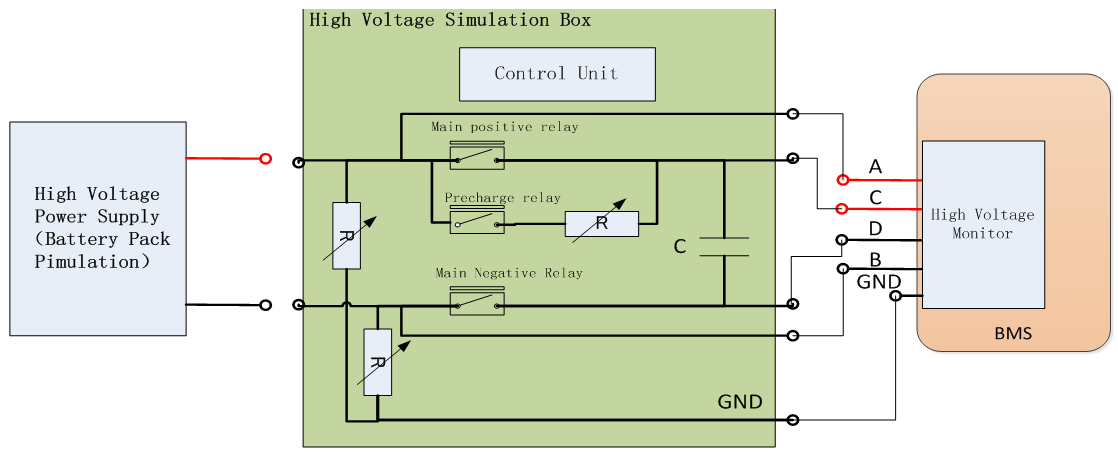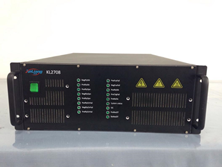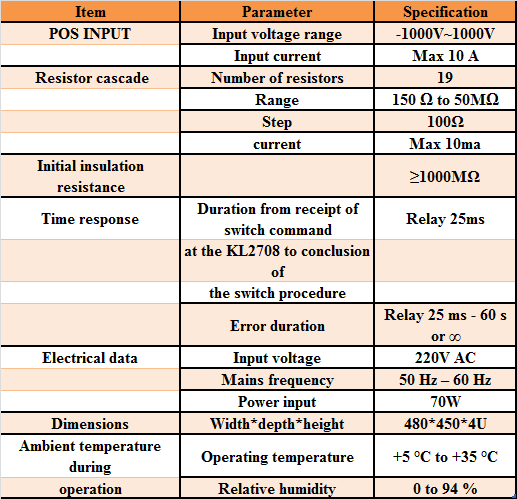
The function of the high voltage simulation box is to simulate the real high voltage circuit characteristics, including pre-charging process, relay failure, etc. There is a pre-charging circuit between the power battery and the motor controller in the electric vehicle, and there are three high-voltage relays three high-voltage relays, namely, a total positive relay, a total negative relay, and a pre-charge relay, and each relay is controlled by the BMS. When the motor starts to work, the user should close the pre-charging circuit before closing the main circuit high-voltage relay, charge the capacitor and judge whether the voltage at both ends of the capacitor meets the requirements. After the requirements are met, the user should close the main circuit high-voltage relay to ensure it safe and reliable when cutting, avoiding arcing.
The high-voltage acquisition of BMS has 4 terminal inputs, two terminals are connected to the battery end, and the other two terminals are connected to the motor inverter end, which can be used to judge the pre-charge degree, and can also be used to monitor the fault condition of the high-voltage relay. The location distribution of each collection point is as shown:

Figure 1 High-voltage circuit schematic
The four points of the ABCD shown in the figure are connected to the BMS high voltage collection end for collection and analysis.
The high-voltage simulation box is used to simulate the pre-charging process and the faults of high-voltage relays. The real pre-charging process is simulated by resistor and capacitor arrays to realize different pre-charging time and faults, which are connected to the total positive and total negative relays respectively. The state of high-voltage relays and the programmable control unit are controlled by the built-in control sheet of high-voltage analog box for unified control.
The principle of the high voltage simulation box is shown below:

Figure. 2 Schematic diagram of High Voltage Simulation Box
The High-voltage Simulation Box is used with the high-voltage power supply to simulate the high-voltage circuit, through the internal high-voltage relay, pre-charge resistor, large capacitor and other modules, the battery pack total voltage, the motor inverter terminal voltage, different pre-charge speeds, High voltage relay failure, precharge circuit failure, insulation failure, etc.
The high voltage power supply in Figure 2 is the battery pack total voltage simulation. The output voltage of the high-voltage power supply is synchronized with the battery cell simulator, and is controlled by the model in the simulator. The high-voltage power supply outputs the total voltage of the power battery, and the battery cell simulator outputs the voltage of each single module. The high voltage power supply is controlled by the serial port, and the high voltage analog box is controlled by the CAN bus (CAN and Ethernet communication interfaces for simulation control). Fault configuration can be achieved through the accompanying PC software (or the high voltage simulator driver module integrated in Simulink).
KL2708 is shown below:

Figure 3 High-voltage Simulation Box Physical Picture
Table1 High Voltage Simulation Box function specification

The High-voltage Simulation Box has the following basic functions:
- Simulate high voltage relay and pre-charge relay failure
- Internal self-test of the system
- Fuse failure of the high voltage output terminal of the battery pack
- The pre-charging resistor burnt out
- Over temperature protection
- Simulate insulation resistance
The high pressure simulation box has the following basic operating characteristics:
- Operating temperature range: -45 ° C ~ 80 ° C
- System insulation value (between high voltage and chassis): ≥100M Ohm
- The high voltage simulation box is programmed via the CAN or Ethernet
- Relay fault type: relay can not be sucked, relay is stuck, relay control line is broken
- Relay fault node: positive and negative main relay failure, pre-charge relay failure
- Pre-charge fault type: the pre-charge voltage cannot rise normally, and the pre-charge is unsuccessful;
- Fuse fault node: positive and negative Fuse faults
Insulation resistance simulation
1) It is possible to simulate the insulation resistance of V+ and V- to the vehicle body at the same time
2) Single-ended insulation resistance range: 150 Ohm ~ 50M Ohm; (maximum current limit 10 mA)
3) Insulation resistance stepping: 100 Ohm
4) The module can simulate an open circuit with an open circuit impedance greater than 100 MΩ
5) The channels are isolated from each other
6) Operating voltage range: -1000V~1000V
7) The resistance of the resistor can be controlled in real time by the host computer software and continuously adjustable
Pre-charge process simulation
1) The pre-charge resistance can be programmed
2) Pre-charging time can be programed